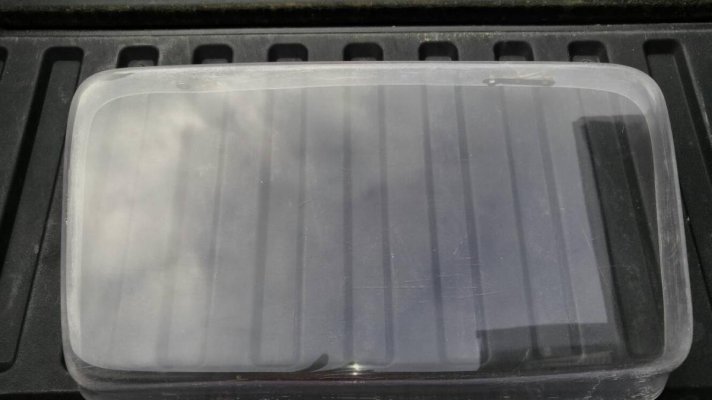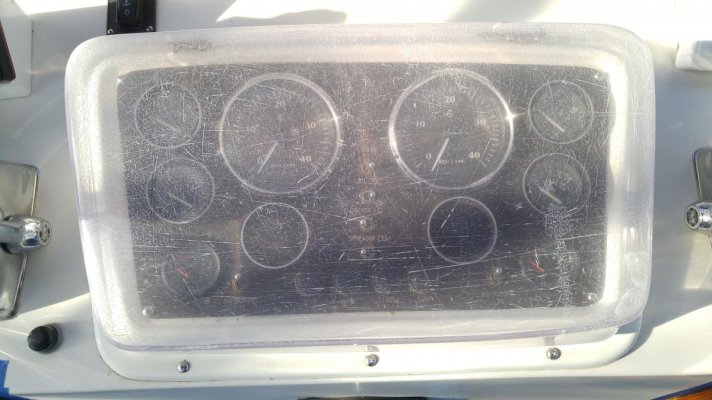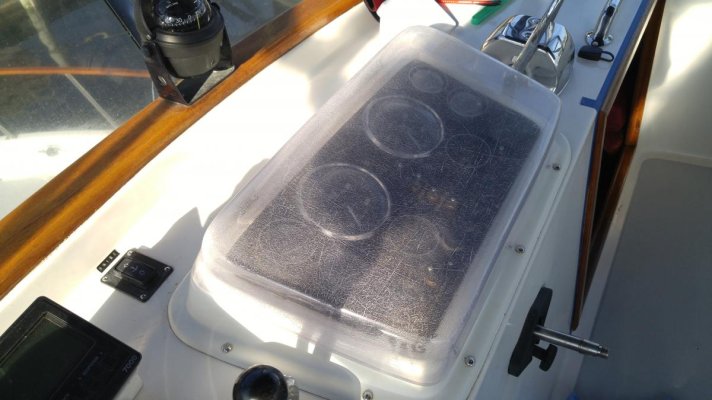You are using an out of date browser. It may not display this or other websites correctly.
You should upgrade or use an alternative browser.
You should upgrade or use an alternative browser.
Bridge instrument cover
- Thread starter fryedaze
- Start date
The friendliest place on the web for anyone who enjoys boating.
If you have answers, please help by responding to the unanswered posts.
If you have answers, please help by responding to the unanswered posts.
DHeckrotte
Guru
Looks like it might be an engine mfr's product, rather than some boat mfr's custom product.
What holds the failed plastic in place? Do I see a white plastic surround and is that surround removable, like is looks? Is the white surround the same sort of plastic, thus likely to be sun-damaged too?
Presuming you cannot source a replacement, and the surround is OK, you could remove the failed lens. Depending upon how it meets the surround, cut it out, rout it out, grind it out. Prepare the remaining surface to accept glue or adhesive sealant. Glue/seal a new piece of sun-resistant plastic in.
Presuming I did not interpret the picture correctly and the clear lens turns down around the edges, then it's much tougher to make a new one. Not impossible to make a new perimeter frame out of: fiberglass, purchased fiberglass sheet/bar (McMaster-Carr) neatly shaped and painted, adhere a new lens.
What holds the failed plastic in place? Do I see a white plastic surround and is that surround removable, like is looks? Is the white surround the same sort of plastic, thus likely to be sun-damaged too?
Presuming you cannot source a replacement, and the surround is OK, you could remove the failed lens. Depending upon how it meets the surround, cut it out, rout it out, grind it out. Prepare the remaining surface to accept glue or adhesive sealant. Glue/seal a new piece of sun-resistant plastic in.
Presuming I did not interpret the picture correctly and the clear lens turns down around the edges, then it's much tougher to make a new one. Not impossible to make a new perimeter frame out of: fiberglass, purchased fiberglass sheet/bar (McMaster-Carr) neatly shaped and painted, adhere a new lens.
caltexflanc
Guru
A local plastic fabricator can duplicate it.
Lepke
Guru
- Joined
- Jun 19, 2016
- Messages
- 3,034
- Location
- US
- Vessel Name
- Charlie Harper
- Vessel Make
- Wheeler Shipyard 83'
The problem is probably caused from UV light. Depending on how thick the cover is, you might buff out the crazing. You can buy a clear UV blocking film that goes on like window tinting. Also there are liquid products that fill the scratches and make it much clearer. Like auto paint restorer.
There is a plexiglass product called Acrylite that has a UV blocker included. Used in museum displays, etc. Works good on flying bridge instruments that can be covered by a flat sheet.
I cover my topside gauges and compass when not in use. Flying bridge compass on my current boat was crazed like your gauge cover when I bought the boat. I buffed it out to perfectly clear.
There is a plexiglass product called Acrylite that has a UV blocker included. Used in museum displays, etc. Works good on flying bridge instruments that can be covered by a flat sheet.
I cover my topside gauges and compass when not in use. Flying bridge compass on my current boat was crazed like your gauge cover when I bought the boat. I buffed it out to perfectly clear.
fryedaze
Guru
- Joined
- Sep 4, 2011
- Messages
- 1,721
- Location
- USA
- Vessel Name
- Fryedaze
- Vessel Make
- MC 42 (Overseas Co) Monk 42
Good ideas, maybe if a fabricator isn't available.Looks like it might be an engine mfr's product, rather than some boat mfr's custom product.
What holds the failed plastic in place? Do I see a white plastic surround and is that surround removable, like is looks? Is the white surround the same sort of plastic, thus likely to be sun-damaged too?
Presuming you cannot source a replacement, and the surround is OK, you could remove the failed lens. Depending upon how it meets the surround, cut it out, rout it out, grind it out. Prepare the remaining surface to accept glue or adhesive sealant. Glue/seal a new piece of sun-resistant plastic in.
Presuming I did not interpret the picture correctly and the clear lens turns down around the edges, then it's much tougher to make a new one. Not impossible to make a new perimeter frame out of: fiberglass, purchased fiberglass sheet/bar (McMaster-Carr) neatly shaped and painted, adhere a new lens.
fryedaze
Guru
- Joined
- Sep 4, 2011
- Messages
- 1,721
- Location
- USA
- Vessel Name
- Fryedaze
- Vessel Make
- MC 42 (Overseas Co) Monk 42
I could do that,, thanks.How good are your wood working skills?
I'd fabricate a trim ring/surround to replace the vertical elements using teak, then mount a flat piece of clear plexi in it.
fryedaze
Guru
- Joined
- Sep 4, 2011
- Messages
- 1,721
- Location
- USA
- Vessel Name
- Fryedaze
- Vessel Make
- MC 42 (Overseas Co) Monk 42
Wow Gordon, have you looked at their website? Everything is suicide preventable products. They must have a niche.Norva plastics in Norfolk Virginia. Send them the old one and they will send you a new one
fryedaze
Guru
- Joined
- Sep 4, 2011
- Messages
- 1,721
- Location
- USA
- Vessel Name
- Fryedaze
- Vessel Make
- MC 42 (Overseas Co) Monk 42
The flaws are not in the surface. They are deeper in the Plexiglas.The problem is probably caused from UV light. Depending on how thick the cover is, you might buff out the crazing. You can buy a clear UV blocking film that goes on like window tinting. Also there are liquid products that fill the scratches and make it much clearer. Like auto paint restorer.
There is a plexiglass product called Acrylite that has a UV blocker included. Used in museum displays, etc. Works good on flying bridge instruments that can be covered by a flat sheet.
I cover my topside gauges and compass when not in use. Flying bridge compass on my current boat was crazed like your gauge cover when I bought the boat. I buffed it out to perfectly clear.
Steve
Guru
We have a similar setup on Monk 36s a couple of the owners have made wood frames as mentioned by Shrew in post #4. Mine suffers from it too but I'm living with it for now. The individual gauge plastic covers are burned a bit too, they are by VDO I imagine when they get too bad replacements are available otherwise the whole gauge if need be.
fryedaze
Guru
- Joined
- Sep 4, 2011
- Messages
- 1,721
- Location
- USA
- Vessel Name
- Fryedaze
- Vessel Make
- MC 42 (Overseas Co) Monk 42
The wood frame sounds good. Fortunately the PO made a cloth cover that is always over the gauges when not in use. The gauges are all in excellent condition.We have a similar setup on Monk 36s a couple of the owners have made wood frames as mentioned by Shrew in post #4. Mine suffers from it too but I'm living with it for now. The individual gauge plastic covers are burned a bit too, they are by VDO I imagine when they get too bad replacements are available otherwise the whole gauge if need be.
fryedaze
Guru
- Joined
- Sep 4, 2011
- Messages
- 1,721
- Location
- USA
- Vessel Name
- Fryedaze
- Vessel Make
- MC 42 (Overseas Co) Monk 42
Ok, I am excited about the chance to build something. May be it will be mahogany instead of teak. $$$ is betterThe wood frame sounds good. Fortunately the PO made a cloth cover that is always over the gauges when not in use. The gauges are all in excellent condition.
stubones99
Guru
The problem is probably caused from UV light. Depending on how thick the cover is, you might buff out the crazing. You can buy a clear UV blocking film that goes on like window tinting. Also there are liquid products that fill the scratches and make it much clearer. Like auto paint restorer.
There is a plexiglass product called Acrylite that has a UV blocker included. Used in museum displays, etc. Works good on flying bridge instruments that can be covered by a flat sheet.
I cover my topside gauges and compass when not in use. Flying bridge compass on my current boat was crazed like your gauge cover when I bought the boat. I buffed it out to perfectly clear.
I’d second this advice...
Then if it didn’t work, build a new one out of plexiglas
fryedaze
Guru
- Joined
- Sep 4, 2011
- Messages
- 1,721
- Location
- USA
- Vessel Name
- Fryedaze
- Vessel Make
- MC 42 (Overseas Co) Monk 42
Found info on web about sanding the plexiglass down. Spent 4 hrs sanding and 2 hrs buffing. Used a half sheet sander and dry sander 80, 120, 180, 220. I could have started with 40 grit. Wet sanded 400, 600, 1500, 2000, 2500. Orbital buffer Presta gelcoat compound, the Presta Chroma polish. It still has alot of deep grazing but the clarity is much better.

Last edited:
stubones99
Guru
You are almost there...
Clean the surface with alcohol.
Get a clear varnish with UV protectant and either foam brush or rattle can spray it with a couple of coats.
5at will clear it up a lot!
Clean the surface with alcohol.
Get a clear varnish with UV protectant and either foam brush or rattle can spray it with a couple of coats.
5at will clear it up a lot!
stubones99
Guru
If you want it even clearer, use rubbing compound on it before painting.
DHeckrotte
Guru
I fear you'll find that the sun-damaged plastic is embrittled through and through. So, having polished it to a fare thee well, you'll have bought yourself some time. The moulded plexiglass fore hatch on our Morgan 27 broke in two one day when slammed shut by wind. It had survived similar treatment for more than 30 years. It was somewhat crazed but really did not look so bad. I took it into a Philly plastic fabricating shop (to have it glued) and the fellow behind the counter diagnosed is a as sun-damaged by listening to it as he rapped on it.
Ever since, I've been unwilling to step on plastic hatch covers that show crazing.
Ever since, I've been unwilling to step on plastic hatch covers that show crazing.
fryedaze
Guru
- Joined
- Sep 4, 2011
- Messages
- 1,721
- Location
- USA
- Vessel Name
- Fryedaze
- Vessel Make
- MC 42 (Overseas Co) Monk 42
You are CORRECT, I have just delayed the replacement a few years.I fear you'll find that the sun-damaged plastic is embrittled through and through. So, having polished it to a fare thee well, you'll have bought yourself some time. The moulded plexiglass fore hatch on our Morgan 27 broke in two one day when slammed shut by wind. It had survived similar treatment for more than 30 years. It was somewhat crazed but really did not look so bad. I took it into a Philly plastic fabricating shop (to have it glued) and the fellow behind the counter diagnosed is a as sun-damaged by listening to it as he rapped on it.
Ever since, I've been unwilling to step on plastic hatch covers that show crazing.
IntervaleII
Senior Member
- Joined
- Mar 31, 2013
- Messages
- 328
- Location
- Japan / United States
- Vessel Name
- Mondai Nai
- Vessel Make
- Nordhaven 55 - 45
I would build a white starboard frame and insert a piece of glass in it. Will never craze and will be easy to keep clean. You could probably make it rectangle and cover the holes. Just a thought which would be easy to make and would look great.
Similar threads
- Replies
- 31
- Views
- 2K



